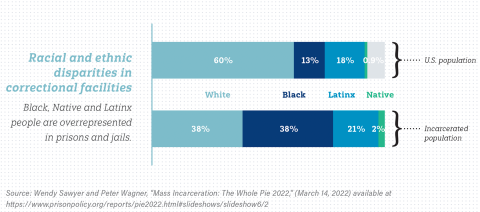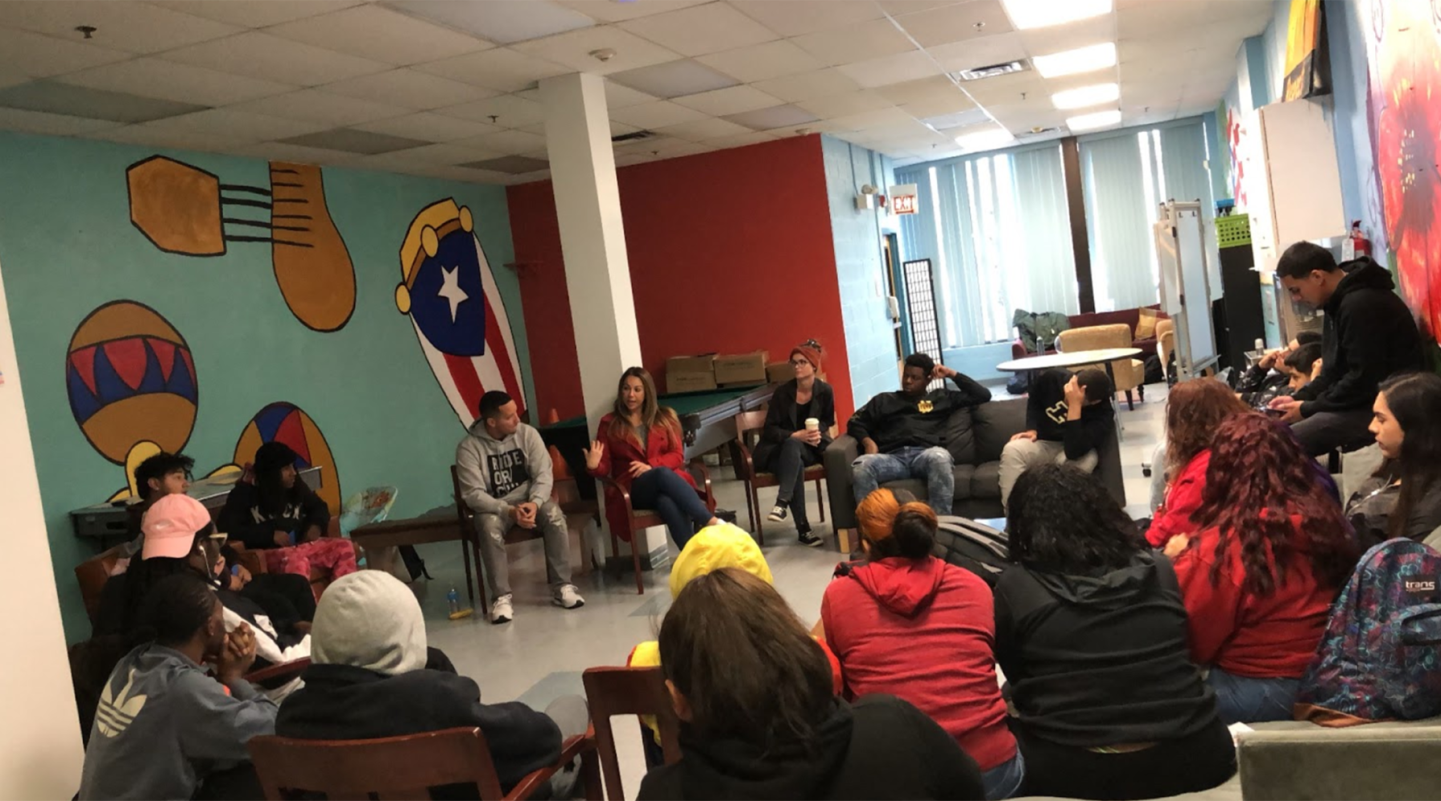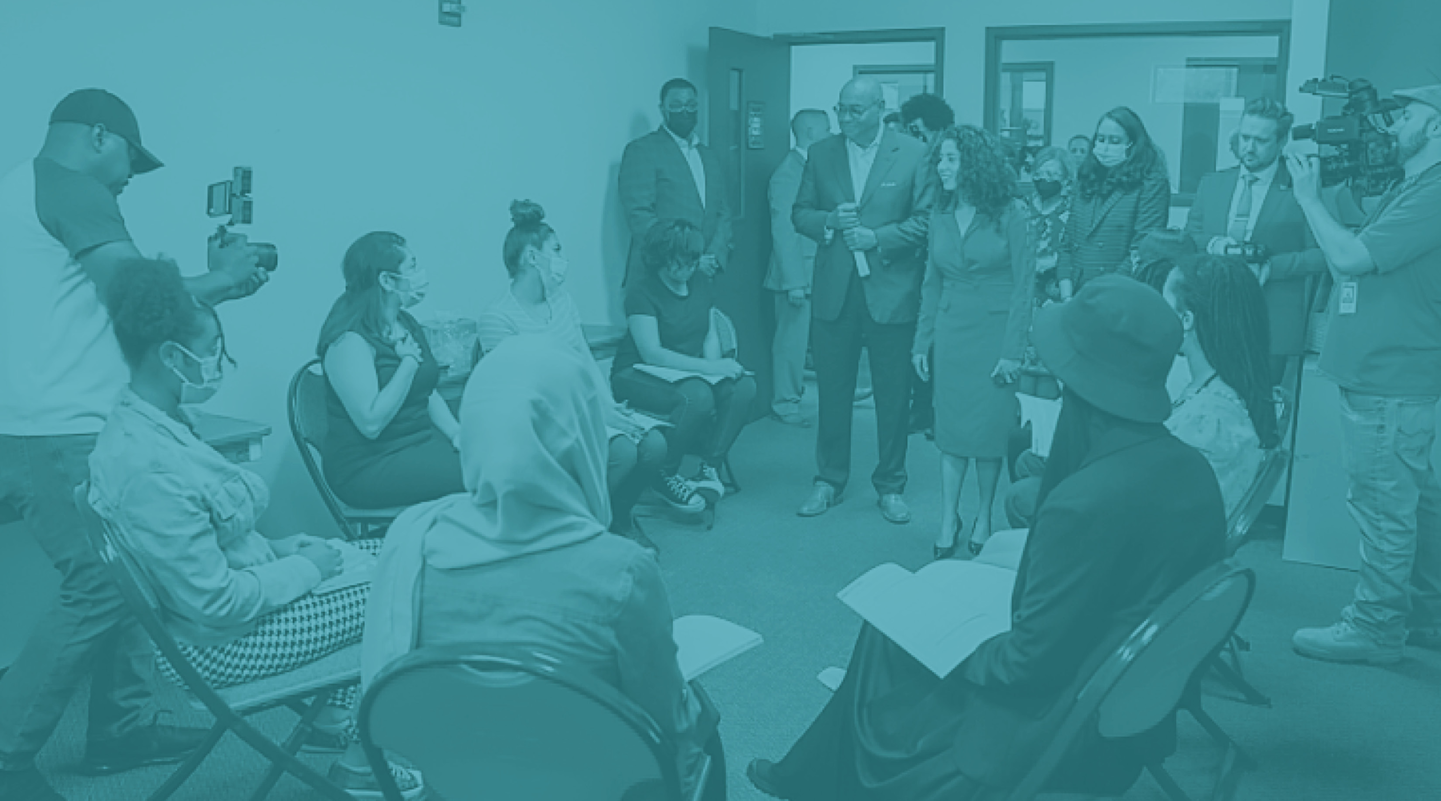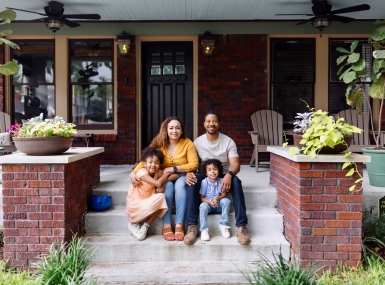
Upcoming Events
Related News
County, state and federal governments play an important role in funding programs and services that support the well-being of community members. Counties invest almost $107 billion annually in justice and public safety services, including law enforcement, courts, corrections, fire services and more.[1] In addition, states administer about $2.5 billion per year in federal formula justice assistance grants to support criminal justice programs.[2] These investments support community safety but must also work in tandem with other social systems and organizations to meet diverse needs and help residents have an equal opportunity to thrive.
To take a more holistic approach to safety, some counties and State Administering Agencies (SAAs) fund community-led organizations that are "by and for" the neighbors they serve. These organizations are deeply embedded in the community and provide services to improve the social fabric of neighborhoods underserved by social service systems and overrepresented in the legal system. They aim to reduce legal system involvement on the front end and support residents returning home from jail or prison.
Investing in community-led organizations is a key strategy for identifying and eliminating racial and ethnic disparities present in the criminal legal system. Nationwide, Black, Latinx and Native American residents are overrepresented in the criminal legal system.[3] For example, Black youth are five times more likely to be incarcerated than their white peers.[4] These disparities stem from historic disinvestment and underinvestment in social systems in communities of color and policies that often prioritize criminal justice responses over meaningful community supports that address socioeconomic and public health needs. As a result, people of color are more likely to be arrested, convicted and sentenced to a lengthy stay in a correctional facility or under supervision.[5] Further, children of incarcerated parents are six times more likely to be incarcerated themselves, creating a multi-generational cycle of legal system involvement.[6]

Recognizing the disparate outcomes and detrimental impact of legal system involvement, counties and SAAs are reimagining this system and investments into the community. Investments in community-led organizations can help reduce these disparities by bridging the gaps in services and supports to help individuals, families and communities thrive. Increasing the number of community-led organizations focused on community life can also improve public safety through reduced violence and property crime.[7]

County and SAA leaders can use budgetary and administrative powers to create meaningful and accessible partnerships and investments in these organizations that will help eliminate disparities, improve outcomes and increase public safety – an opportunity that is overwhelmingly supported by the majority of Americans.[8]
The National Association of Counties and the National Criminal Justice Association, with support from the U.S. Department of Justice’s Bureau of Justice Assistance, convened a working group of county stakeholders, SAA representatives and community-led organization leaders to develop principles, strategies and practices for equitable grantmaking. These principles, applicable across funding areas, can help ensure that community-led organizations are equitably resourced as part of the broader continuum of community safety. They reflect both cultural and operational shifts, many of which can be undertaken with little to no cost. Underpinning each principle is the working group’s definitions of equity and community.
Equity: A process of identifying and eliminating disparities, shifting of power and removing barriers that perpetuate inequity. It is the intentional practice of change to actualize fair treatment, advancement, access and opportunity for all to thrive.[*]
This report outlines the eight guiding principles to enhance equity in grantmaking that the working group developed and provides strategies, practical solutions and county examples aligned with each principle.

Key Takeaways
Counties considering opportunities to reduce racial and ethnic disparities in the criminal legal system may choose to partner with and invest in community-led organizations. To help guide this investment, counties may choose to guide their decision making with:
Principles
Trust
Trusting partnerships can open lines of communication, encourage a willingness to innovate and strengthen opportunities for mutual respect. Investing in the capacity and expertise of community leadership helps shift power to the people doing work and retire the risk averse mindset often associated with grantmaking. During a project, a grantee may struggle to meet all funding requirements, but these challenges should not diminish the strengths a grantee brings to the work or their potential while learning how to comply with such conditions. Anchoring the relationship in a common goal that all parties strive to achieve can serve as a guidepost during implementation challenges. Rejecting the funder/recipient power dynamic that can stifle relationships helps to see one another as partners. Learning from and listening to one another as partners increases the understanding of what works in the community and what barriers remain. As experts in their communities, community-led organizations are closest to the solutions.
PRACTICES to strengthen trust include:
- piloting initiatives
- hosting meetings focused on relationship building
- setting clear expectations, roles and responsibilities, and
- partnering with State Administering Agencies (SAAs), neighboring counties and towns, as well as philanthropic entities, to streamline funding and share best practices.
Lucas County, Ohio (Pop. 431,279) commissioners dedicated $200,000 to community-led organizations engaging in criminal justice reform efforts and addressing racial disparities.[9] The grant fund provides up to $10,000 awards to grassroot organizations working in four zip codes. The county Criminal Justice Coordinating Council (CJCC) also administers federal criminal and juvenile justice funds on behalf of the state to allow for greater flexibility while continuing to provide oversight and technical assistance.[10]
Hearing from community advocates, Harris County, Texas (Pop. 4,731,145) leaders dedicated $4 million to the Youth Justice Community Reinvestment Fund to re-envision youth safety and reduce disparities in juvenile detention via investments in community-led organizations.[12] An intermediary organization administers the funds and partners with grantees to enhance their organizational capacity. Funds are directed towards organizations most impacted by the juvenile justice system and that employ staff who reflect the community they serve.

In Their Words
"We need to facilitate more discussion for a process that includes the community to think about how we reform our legal system. We think that supporting community organizations is a step in building trust and incorporating more people in the process to improve our justice system."
Gary L. Byers, Commissioner, Lucas County, Ohio11[11]
Transparency
Publishing and sharing materials and decisions often contributes to increased buy-in, accountability and mutual understanding. Prioritizing an open and ongoing commitment to share information in a timely and helpful manner can help both parties understand the purpose of certain activities and why some information cannot be shared, as well as manage expectations. Announcing the process surrounding decision making and personnel/advisors involved helps community-led organizations understand the decision-making process and how the proposals will be scored. Communicating the purpose of data-collection efforts and results of the programs helps community-led organizations tailor the data they collect.
PRACTICES to enhance transparency include:
- requesting only essential paperwork at the application stage
- providing comprehensive feedback on unsuccessful applications
- sharing information regarding the availability of advances and/or cost reimbursement timeframes
- posting a timeline of key decision points, application steps, scoring criteria and grant monitoring requirements in user-friendly formats to reduce or eliminate surprises, and
- sharing outcomes of funded projects publicly.
Via working group recommendations in Dane County, Wis. (Pop. 561,504), county leaders piloted an initiative and continued the funding through the Partners in Equity Grant Program to fund grassroots organizations that aim to reduce legal system involvement and address systemic racial inequities. Organizations can apply for up to $15,000 in funding. Additionally, the county requested an external evaluation of grantmaking policies and practices to enhance racial and social equity across departments.[13]
The District of Columbia (Pop. 689,545) Office of Victim Services and Justice Grants employs several strategies to administer funds equitably. To better understand the impact of the resources, grant managers are required to attend grantee events outside of grant monitoring. In addition, the agency provides a host of grant management resources for organizations and often matches grant managers to grantees based on capacity to provide relevant assistance.[14] Receiving both local and federal funds, the agency capitalizes on the flexibility of local funding for certain projects. Additionally, grantees may request advance payments to facilitate meeting the goals and objectives of their grant. To support new grant applicants, the agency may conduct a pre-decision site visit to learn more about the program and understand how government resources could assist. Recognizing the importance of engaging the community and valuing their time and expertise, community members are paid to serve as proposal reviewers.
Community
Investing in community-led organizations helps fund programs and services most needed in neighborhoods. Supporting “by and for” organizations prioritizes grassroots organizations deeply embedded in the communities they serve. Including community member voices in the decision-making process can open the avenue for direct input on funding needs and priorities. Proactively engaging community representation helps to identify, involve and uplift the community members and organizations beyond those who are often well-established or well-known.
PRACTICES to invest in community include:
- utilizing an equity scorecard to prioritize organizations within certain neighborhoods that may receive an outsized benefit from the resources
- providing an honorarium to residents who serve on application review panels or task forces
- reserving a seat on the local criminal justice coordinating council for community members/people with lived experience
- hosting listening sessions in different communities at different times, including weekends, to accommodate work schedules, and
- offering support services such as transportation or child care during community meetings.
Through the Community-Based Violence Prevention Partnership, Indianapolis-Marion County, Ind. (Pop. 977,203) invests $300,000 annually in community-led organizations that offer evidence-based violence prevention services in neighborhoods with violent crime rates that exceed the city-wide average. The proposal review panel conducts site visits and/or interviews to learn about each applicant’s work. In addition, a community-based intermediary administers funding for the Violent Crime Prevention Grants Program that prioritizes neighborhood-based, resident-driven organizations working to prevent or reduce crime. Communities associated with higher violent crime rates receive more resources.[15] Grants range from $500 to $40,000 to provide manageable awards and reach organizations that may not have been previously eligible for funding.[16]
Through a local initiative in the Minnesota Department of Health’s Statewide Health Improvement Partnership, which supports well-being and health, leaders in Blue Earth County, Minn. (Pop. 69,112) leverage the community’s “collective intelligence” to identify problems, develop effective solutions and dedicate community resources.[17] The county provides technical assistance and expertise to grantees during planning and implementation. The Community Leadership Team, comprised of county staff and community partners, helps to engage community members.
Fairness
Leaders in Multnomah County, Ore. (Pop. 815,428) evaluated county investments to fund programs that address the underlying drivers of harmful behavior and uplift communities of color.[18] The county expanded the Community Healing Initiative that invests resources in community-based partnerships to support youth and families. The program deploys culturally-specific services and provides direct relief such as rent, utilities and internet access. To support smaller and emerging organizations, the county is piloting an initiative to provide 13 months of funding for year-long projects to jumpstart their programming with resources. |
Implementing new processes to enhance fairness in the types of organizations funded and how these funds are administered will help improve access and equity. Training staff to recognize, reflect and address personal and organizational bias can support those who may serve as proposal reviewers or write Request for Proposals. Understanding and addressing biases can help to shift perceptions of grantees to view them as experts in their communities with the capacity to use county resources wisely. Education and training can also help embed equity within county cultural norms to enhance ongoing work and sustainability. Promoting practices that allow grantees to contribute to the grantmaking process can enhance continued and active engagement from prospective applicants and current or previous grantees. Raising up champions can help spotlight county staff and grantees as leaders and experts to support sustainability. Not lowering the bar but raising the platform finds avenues to increase access, inclusion, support, capacity building efforts and equity without diminishing service delivery or grantee performance standards. For example, revising processes to open funding opportunities and offer technical assistance can help build community-led organizations’ capacity and capability to receive and effectively use grant funds.
PRACTICES to bolster fairness include:
- offering bias education and training for employees that focus on the narrative and messaging of equity
- regularly reviewing the funding process
- soliciting community and staff input through intentional outreach, online forms and listening sessions
- sharing resources and lessons learned among stakeholders to leverage existing work, and
- rightsizing grant requirements to community needs.
Intentional Access & Inclusion
Aligning resources with equity goals and removing barriers to participation and use of funding will expand and diversify grantee opportunities and potential relationships. To this end, refining grant requirements to enhance practicality will support access and inclusion for all potential grantees. Considering the structure and level of funding helps smaller organizations and/or those newer to government funding. Similarly, allowing for various entry points can diversify the grantee pool by funding organizations implementing new programs and building their capacity. Evaluating needed changes in the application process and components can open the primary entry point into a county’s grant pipeline. Measuring and broadening success can help shape how outcomes are determined and develop a realistic and appropriate infrastructure for data reporting to support programmatic success that often begets more grant funding. It is helpful for county funders to view grants as long-term investments that demonstrate meaningful results several years after implementation.
PRACTICES to expand intentional access and inclusion may reflect:
- providing advance payments and/or quicker payment
- awarding multi-year funding and/or general operating resources
- allowing video submissions or meetings in lieu of a formal written proposal
- requiring only the materials that are necessary during the proposal stage
- setting realistic timelines for outcome reporting
- selecting key data points (outputs and outcomes) that are relevant for funders and organizations
- tailoring metrics to organizational capability and focus
- offering tiered funding streams so similarly situated organizations apply within a funding bracket
- scaling programs, and
- offering grants that are manageable for an organization’s capacity.
The Office of Drug Control Policy (ODCP) of Harford County, Md. (Pop. 260,924) provides $5,000 grants to community-led organizations developing new or creative programs that aim to prevent crime and/or substance misuse among youth. Preference is given to new organizations that may not be eligible for other sources of funding. To strengthen the partnership with community organizations, ODCP staff often participate in funded programs.
The Criminal Justice Microgrant Fund in Philadelphia, Pa. (Pop. 1,603,797) provides resources to community-led organizations engaged in innovative criminal justice reform efforts. Funding can be used to support communities disproportionately impacted by the criminal legal system or provide services to residents who are involved in the system. Organizations led by people of color may also seek general operating support.

In Their Words
"The District Attorney’s Office and City of Philadelphia’s efforts to reform the criminal legal system can only be successful if local organizations that know their communities best are empowered to realize long-held visions for safety, inclusion, and justice."
Larry Krasner, District Attorney, Philadelphia, Pa.[19]
Support
Providing an infrastructure of support and resources for community-led organizations, particularly those new to applying for and/or receiving government funding, can help successfully manage funds. Providing culturally and socially responsive training, technical assistance and coaching offers support “beyond the paycheck” that can assist with the financial, technical and operational pieces of grant management. This support can help build an organization’s ability to successfully manage and secure additional funding. Investing in funder internal capacity helps build infrastructure to enhance funding and technical assistance available to community-led organizations. Engaging intermediaries leverages their experience and expertise to provide “back end” support. Intermediary organizations can lead the grantmaking process to free up government agency resources as well as provide leadership, infrastructure (data tracking and fiscal systems), technical assistance, capacity building, resources and coordination to grantees. For example, the Latino Coalition for Community Leadership (LCCL) serves as the intermediary for a program investing in community-led organizations providing reentry services and has successfully enhanced grantees’ service provision and capacity.[20]
PRACTICES to improve support include:
- offering presentations and workshops before application submission and during implementation, as well as one-on-one technical assistance, and pre-decision site visits
- partnering with an intermediary, and
- hiring a grants administrator to help disseminate grant opportunities, provide guidance and secure outside resources.
Milwaukee County, Wis. (Pop. 939,489) Community Justice Council is providing four grassroots organizations working to reduce or prevent criminal legal system involvement, promote racial equity and engage the community with $34,500 each.[21] To support applications, the Community Justice Council sponsored a community grant writing training, hosted an optional information session prior to the submission deadline and published the scoring rubric. During the grant period, grantees are required to attend a new grantee orientation and meetings to discuss expectations, support grant administration and offer connections among the group. A local university serves as the fiscal agent to help grantees meet reporting requirements and disperse funds more support.
The grants administrator in Lewis and Clark County, Mont. (Pop. 70,973) helps secure funding to fill county and community needs.[22] The grants administrator informs the county and community partners of potential grant opportunities and assists with grant applications and administration. To understand community needs with respect to affordable housing, economic development, neighborhood revitalization, and community and public facilities, the county and the city of Helena host an annual community needs assessment meeting.
Creativity
While working within the confines of funding rules and requirements may pose challenges, it can be beneficial to evaluate and revise processes. Honoring and uplifting creativity and innovation can help to challenge and expand standard practices to work for both sides of the grantmaking equation more effectively. Learning, sharing and evolving beyond the status quo aids in county growth and alignment with community needs by reflecting on the current processes and exploring ways for improvement. Utilizing the tools, discretion and flexibility available to the government can help to understand the available resources that allow for more effective grants management.
PRACTICES to foster creativity may include:
- conducting self-assessments[†]
- seeking community input on the grantmaking process
- revisiting invoice procedures to ensure prompt payment, and
- revising reporting requirements.
Residents in Los Angeles County, Calif. (Pop. 10,014,009) approved Measure J in 2020 to dedicate no less than 10 percent of the county’s locally generated, unrestricted funding to community investments that address the disproportionate impact of racial injustice. The county established a 24-member committee that can garner community input and project recommendations through an online form, in both English and Spanish. A community-based, third-party administrator and a community engagement consultant ensure diverse community voices are elevated and incorporated into the decision-making process.
The Douglas County, Nev. (Pop. 49,488) Board of County Commissioners decides annually whether to approve funding for the Community Grant Program to support community organizations that provide services to county residents. The Community Grant Committee assessed and updated the program to streamline the application process to improve practicality.[23]

County and State Administering Agency (SAA) Partnerships
Partnerships between counties and SAAs, such as the one between Cook County, Ill. and the Illinois Criminal Justice Information Authority, help enhance trust by creating opportunities to learn from each other. Through developing open lines of communication and spaces to collaborate, these groups discuss challenges in grantmaking, brainstorm appropriate solutions and share innovations. For example, Cook County and the Illinois SAA have shared best practices regarding advance payment policies, the application process and engaging with community members to improve their grantmaking. This collaboration helps both entities learn from one another and reflect on the opportunities to address community needs by building upon previous activities, rather than reinventing the process.
Joint Accountability
Cook County, Ill. (Pop. 5,275,541) launched a 50-member taskforce to advise on the county’s strategic investments.[24] One of the grant programs invests in community-led organizations that serve areas with disproportionately high rates of gun violence. Tiered funding tracks with staggered deadlines provide organizations that may have smaller budgets and/or grant writing capacity with time to submit strong applications and be evaluated among similarly situated organizations.[25] The grant funding is provided on a quarterly basis, rather than a reimbursement, and grantees may request a funding advance. Organizations that are led by, support or employ community members with criminal convictions are not barred from applying on that basis. |
As stewards of public dollars, government funders and community-led organizations play a critical role in responding to and serving community members’ needs. Prioritizing intentional investments in communities traditionally left out of the funding process can help government funders be more responsive to local needs. Communicating funder expectations can help community-led organizations respond to local needs and effectively deliver services while developing systems for community-led organizations to be good stewards of county resources. Committing to sharing data on both sides of the funding equation can help reinforce the goal of the investment and align resources as needs evolve. Building a working relationship with continued communication and support can provide opportunities to enhance trust and target funding to amplify impact.
PRACTICES to support joint accountability may include:
- meetings to learn how community-led organizations are directing resources
- learning about the intermediary impacts of the funding, and
- taking intentional steps to diversify the grantee pool, open application entry points and focus resources on community needs.

Conclusion
Capitalizing on national momentum to address and reduce racial and ethnic disparities in the criminal legal system, counties have an opportunity to reflect on grantmaking processes to administer funds more equitably and for greater impact. Community-led organizations are critical partners and trustees in this work. Through aligning resources with practices that prioritize trust, transparency, community, fairness, intentional access and inclusion, support, creativity and joint accountability, counties can better serve residents and create vibrant communities.
Acknowledgements
This report was created with the support of Grant No. 2016-YA-BX-K002, awarded by the Bureau of Justice Assistance. The Bureau of Justice Assistance is a component of the Office of Justice Programs, which also includes the Bureau of Justice Statistics, the National Institute of Justice, the Office of Juvenile Justice and Delinquency Prevention, the SMART Office, and the Office for Victims of Crime. Points of view or opinions are those of the authors.
This report was researched and written by Chelsea Thomson, Justice Program Manager, with support and guidance from Nastassia Walsh, Director, Programs and Operations as well as Gillian Caplan and Allison Badger from the National Criminal Justice Association and project facilitators Latrina Kelly-James and Heather Warnken.
This toolkit is based on the input and expertise shared by the working group and invited speakers during four meetings between January and June 2022. NACo would like to thank the following individuals for their contributions:
Delrice Adams
Director
Illinois Criminal Justice Information Authority
Greg Jones
Office of Equity and Inclusion Advisory Chair
Dane County, Wis.
Ryan Keck
Programs Director
Oregon Criminal Justice Commission
Devon McDonald
Executive Director
Indiana Criminal Justice Institute
Richard Morales
Deputy Executive Director
Latino Coalition for Community Leadership
Ken Sanchagrin
Director
Oregon Criminal Justice Commission
Helene Zentner
Field Representative
California Board of State and Community Corrections
Lanetta Haynes Turner
Chief of Staff, President Toni Preckwinkle
Cook County, Ill.
Hon. Deborah Kafoury
County Chair
Multnomah County, Ore.
Holly Matthews
Executive Director, Criminal Justice Coordinating Council
Lucas County, Ohio
Kim Melton
Chief of Staff, Chair Deborah Kafoury
Multnomah County, Ore.
John Prince
Deputy Director
California Board of State and Community Corrections
Hon. Vance Stuehrenberg
District 2 Commissioner
Blue Earth County, Minn.
Michelle Garcia
Director
District of Columbia Office of Victim Services and Justice Grants
Hassan Latif
Founder
Second Chance Center
Ashley McSwain
Executive Director
Community Family Life Service
Elizabeth Jones Valderrama
Executive Director
OAR of Arlington, Alexandria and Falls Church
Anne Marks
Executive Director
Youth ALIVE!
Latrina Kelly-James
Principal
Oya Strategies
Heather Warnken
Executive Director, Center for Criminal Justice Reform
University of Baltimore School of Law
References
[*] The National Association of Counties’ (NACo) definition of equity is “the process of identifying and removing the barriers that create disparities in the access to resources and means, and the achievement of fair treatment and equal opportunities to thrive." The working group expanded on NACo’s definition to reflect the group’s experiences and discussions.
[†] Justice Funders offers a tool to align grantmaking practices within an equity framework. A full overview of the guide can be found here: http://justicefunders.org/choir-book/
[1] National Association of Counties, “The County Landscape,” (2022) available at https://www.naco.org/sites/default/files/documents/The%20County%20Landscape_0.pdf (May 26, 2022)
[2] National Criminal Justice Association, “State Administering Agencies,” (n.d.) available at https://www.ncja.org/about-saas (May 9, 2022)
[3] Wendy Sawyer and Peter Wagner, “Mass Incarceration: The Whole Pie 2022,” (March 14, 2022) available at https://www.prisonpolicy.org/reports/pie2022.html#slideshows/slideshow6/2 (March 28, 2022)
[4] Josh Rovner, “Racial Disparities in Youth Incarceration Persist,” (February 3, 2021) available at https://www.sentencingproject.org/publications/racial-disparities-in-youth-incarceration-persist/ (March 16, 2022)
[5] The Sentencing Project, “Report to the United Nations on Racial Disparities in the U.S. Criminal Justice System,” (April 19, 2018) available at https://www.sentencingproject.org/publications/un-report-on-racial-disparities/ (March 16, 2022)
[6] Eric Martin, “Hidden Consequences: The Impact of Incarceration on Dependent Children,” (May 2017) available at https://www.ojp.gov/pdffiles1/nij/250349.pdf (March 15, 2022)
[7] Patrick Sharkey, Gerard Torrats-Espinosa and Delaram Takyar, “Community and the Crime Decline: The Causal Effect of Local Nonprofits on Violent Crime,” (October 25, 2017) available at https://journals.sagepub.com/eprint/VThwp5JSFz7eNKF5GkxW/full (March 14, 2022)
[8] Lake Research Partners, “Survey Findings on Community Investment,” (December 11, 2017) available at https://www.urban.org/sites/default/files/2018/02/05/polling_memo.pdf (March 15, 2022)
[9] Zeinab Cheaib, “Lucas County to award $100K in grants to community organizations for fighting racial disparity in jails, aiding criminal justice reform” (November 1, 2021) available at https://www.wtol.com/article/news/local/lucas-county-100k-grants-to-community-organizations-for-fighting-racial-disparity-jails-and-criminal-justice-refo/512-a699e88e-2e10-46fa-8150-066dc448023a (March 21, 2022)
[10] Lucas County Criminal Justice Coordinating Council, “Grants Management,” (n.d.) available at https://lucascountycjcc.org/Grants (March 21, 2022)
[11] Zeinab Cheaib, “Lucas County to award $100K in grants to community organizations for fighting racial disparity in jails, aiding criminal justice reform” (November 1, 2021) available at https://www.wtol.com/article/news/local/lucas-county-100k-grants-to-community-organizations-for-fighting-racial-disparity-jails-and-criminal-justice-refo/512-a699e88e-2e10-46fa-8150-066dc448023a (March 21, 2022)
[12] Harris County, “Harris County Commissioners Approve First of Its Kind Community-led Multi-million Dollar Youth Justice Community Reinvestment Fund,” (February 10, 2021) available at https://cmjcenter.org/documents/Harris-Co-Justice-Administration-Press-Release-Youth-Justice-Community-Reinvestment-Fund.pdf (March 29, 2022)
[13] MGT Consulting Group, “Contracting and Procurement Evaluation Dane County,” (August 2017) available at https://board.countyofdane.com/documents/pdf/reports/FINAL-Dane-County-Contracting-Equity-Report-August-15--2017.pdf (April 5, 2022)
[14] Office of Victim Services and Justice Grants, “Grant Management Resources,” (n.d.) available at https://ovsjg.dc.gov/page/grant-management-resources (March 15, 2022)
[15] CICF, “District Crime Prevention Grants,” (n.d.) available at https://www.cicf.org/district-crime-prevention-grants/ (March 24, 2022)
[16] CICF, “Council District Crime Prevention Grants Program,” (April 1, 2021) available at https://www.cicf.org/2021/04/01/council-district-crime-prevention-grants-program/ (March 24, 2022)
[17] Blue Earth County, “Community Engagement,” (n.d.) available at https://www.blueearthcountymn.gov/1149/Community-Engagement (March 15, 2022)
[18] Multnomah County, “Budget Priorities: Defunding and Reinvesting,” (March 2022) available at https://www.multco.us/justiceagenda/budget-priorities (March 16, 2022)
[19] City of Philadelphia, “City Announces Two Microgrant Programs to Aid in Criminal Justice Reform Efforts,” (September 22, 2020) available at https://www.phila.gov/2020-09-22-city-announces-two-microgrant-programs-to-aid-in-criminal-justice-reform-efforts/ (March 17, 2022)
[20] Chelsea Thomson, Leah Sakala, Ryan King and Samantha Harvell, “Investing Justice Resources to Address Community Needs,” (February 2018) available at https://www.urban.org/sites/default/files/publication/96341/investing_justice_resources_to_address_community_needs_1.pdf (March 17, 2022)
[21] Milwaukee Community Justice Council, “Milwaukee Community Justice Council Announces Subgrant Awards to 4 Community Organizations,” (April 27, 2022) available at https://www.milwaukee.gov/EN/MCJC/Blog/2022/4-27-2022SubgrantAnnouncement (June 1, 2022)
[22] Lewis and Clark County, “Grants Program,” (n.d.) available at https://www.lccountymt.gov/cdp/county-grants-program.html (March 15, 2022)
[23] Douglas County, “Grant Committee Recommendation,” (n.d.) available at https://cdn5-hosted.civiclive.com/UserFiles/Servers/Server_12493019/File/Finance/Community%20Grant/FY20-21%20Recommendation%20Report.pdf (March 18, 2022)
[24] Cook County, “President Preckwinkle Announces Launch of Cook County Equity fund Taskforce,” (May 6, 2021) available at https://www.cookcountyil.gov/news/president-preckwinkle-announces-launch-cook-county-equity-fund-taskforce (March 18, 2022)
[25] Cook County Justice Advisory Council, “Frequently Asked Questions & Answers,” (March 21, 2022) available at https://www.cookcountyil.gov/sites/g/files/ywwepo161/files/documents/2022-03/FAQs%20for%20JAC%20Gun%20Violence%20Prevention%20Grants%203_21_22%20%281%29.pdf (April 5, 2022)





